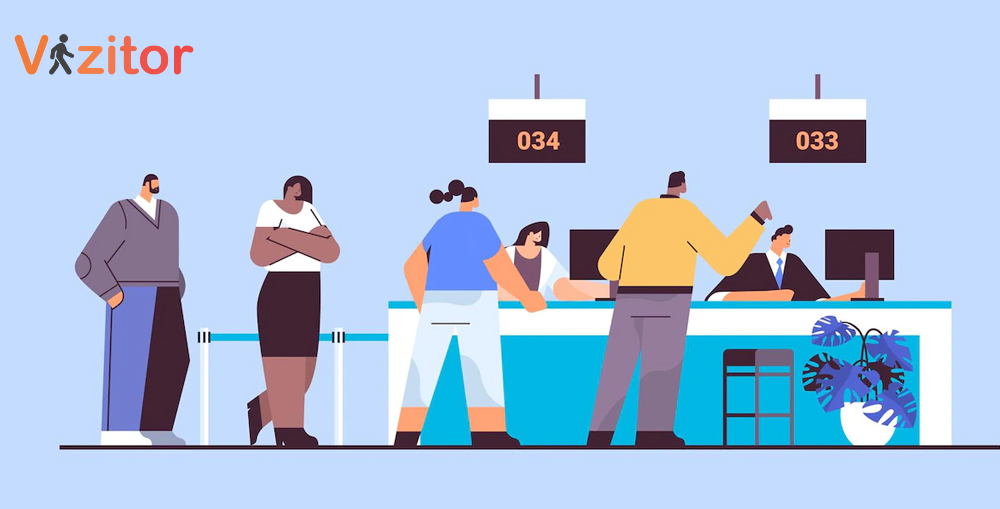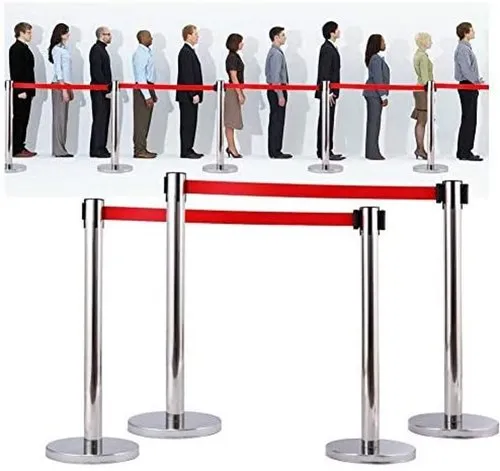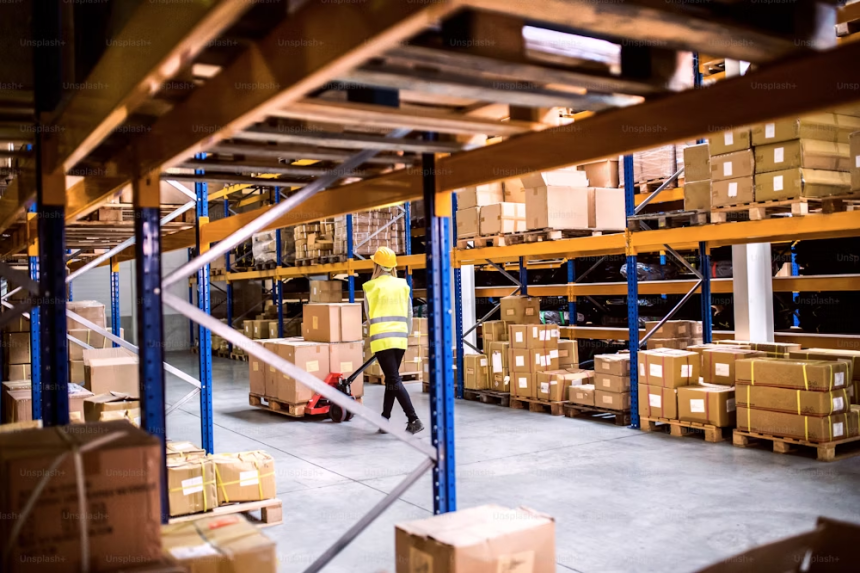Table of Content
Try Vizitor for Free!

Tue, Mar 11, 2025
Read in 8 minutes
Imagine stepping into a busy hospital, retail store, or airport, only to find yourself stuck in a disorganized, long queue. You have no idea how long you’ll wait, and frustration starts building.
💡 Did you know?
- 90% of customers avoid businesses with long wait times (Zendesk).
- Businesses lose up to 75% of potential customers due to poor queue management (Harvard Business Review).
A Queue Manager helps businesses control visitor flow, reduce wait times, and improve efficiency. But what type of queue manager should you use – a physical queue manager or a digital queue management system?
Let’s explore!
What is a Queue Manager?
A queue manager, also known as a q manager or que manager, is a system that controls how tasks and processes are queued, prioritized, and executed. Queue managers are widely used in enterprise applications, customer service workflows, and IT infrastructure to optimize operations and reduce waiting times.\
With the shift toward digital technologies, businesses now adopt smarter solutions that enhance customer satisfaction and increase productivity.
Queue management has evolved from physical tools like stanchions and ticket systems to digital queuing processes.
A Queue Manager isn’t just about organizing lines; it’s about creating a seamless, efficient experience for customers and improving operational efficiency for businesses.
Amazing Stats:
• 90% of customers avoid businesses with long wait times (Zendesk Customer Experience Report)
• Businesses lose up to 75% of potential customers due to long waiting times (Harvard Business Review)
• According to a study by Genetic Engineering & Biotechnology News (GEN),70% of customers report that poor queue management negatively impacts their overall experience.
Queue managers can be categorized into two types:
✓ Physical Queue Managers: Traditional systems like stanchions, ticket dispensers, and signage.
✓ Digital Queue Managers: Automated systems that allow visitors to join virtual queues and receive updates remotely.
While both systems aim to manage the flow of people, digital queue managers have gained popularity for their ability to offer a more streamlined, data-driven approach.
Benefits of Using Queue Managers in High-Traffic Areas
✓ Organized Queue Flow: Que managers ensure that customers stand in a single, orderly line. This not only makes the process smoother for everyone but also helps minimize confusion and frustration in high-traffic environments.
✓ Enhanced Customer Experience: By reducing wait times and creating an organized space, businesses and event venues can offer a more pleasant experience to their customers and attendees.
In busy malls or airports, digital queuing enables customers to wait remotely, which enhances the overall shopping or travel experience.
✓ Enforcing Social Distancing: In the wake of the pandemic, businesses have placed a greater emphasis on social distancing. Q managers provide a simple yet effective solution by spacing customers 3-6 feet apart in the queue. This allows businesses to maintain safety measures while keeping customer traffic flowing smoothly.
✓ Space Optimization: Queue managers allow businesses and event venues to effectively use the available space, ensuring that customers don’t crowd one area but follow a structured path. This can be crucial in places like malls or convention centers where foot traffic is dense and uncontrolled queues can cause disruption.
✓ Improved Efficiency: With well-organized queues, businesses can reduce customer frustration, leading to quicker service and more efficient operations.
How Physical Queue Managers Work?
For many years, physical queue managers were the go-to solution for handling crowds. These methods are still in use today, but they come with their own set of challenges
Stanchions and Barriers: These are the physical dividers used to direct people into lines. Common in airports, banks, and theme parks, stanchions help prevent chaos, but they require more space and can still lead to congestion during peak hours.
Token Systems: Visitors receive a token (often with a number) and wait for their number to be called. This system is typically used in government offices or medical clinics.
Manual Check-In Systems: In this system, staff manually check customers into a queue, which can lead to delays or errors.
Single-Belt Queue Managers
One of the most common types of queue managers is the single-belt queue manager.
These systems use a single retractable belt that can be attached to metal posts, creating a defined path for individuals to follow.
The retractable design makes it easy to adjust the length and shape of the queue to suit various spaces and event sizes. This type of que manager is widely used in places like airports, theatres, government offices, shopping malls, and exhibition halls.
Real World Applications of Queue Managers
Queue Managers are used across various industries, such as:
✓ Corporate Offices: Efficiently manage visitors and employees checking in for meetings or services.
✓ Healthcare Facilities: Ensure patients are served in a comfortable way while maintaining a safe and organized environment.Queue managers reduce crowding, particularly in emergency rooms or outpatient departments.
✓ Retail and Banking: Provide customers with a seamless shopping or banking experience without long wait times. Physical queue systems like barriers help organize customers, ensuring a better in-store experience.
✓ Educational Institutions: Manage student and parent queues during admissions or events.
Using physical posts and ropes or chains as a queue manager is a traditional yet effective way to organize large crowds, preventing the chaos of people pushing each other to gain entry into business premises or event halls , but digital queue systems have begun to take over in places where efficiency and contactless services are becoming increasingly important in the queue management process.
Businesses and event organizers are looking towards more smart and digital queuing solutions like Vizitor’s Queue Management System, which integrates both physical and digital solutions for effective queue management.
According to a report by Market Research Future, the global Queue Management System (QMS) market is expected to grow at a significant rate over the coming years.
Digital Queuing: A Smarter Way to Handle Queues
However, as customer expectations evolve, digital queuing is quickly becoming the preferred choice for many businesses. Digital queue management offers several key benefits that go beyond just organizing a line.
These systems not only reduce physical congestion but also provide real-time updates, automate check-ins, and give businesses valuable insights into customer behavior.
Key Features of Digital Queue Managers:
Virtual Queuing: Customers can join a virtual queue from their mobile devices, websites, or kiosks, allowing them to wait in comfort without standing in a physical line.
Real-Time Updates: Through notifications, customers are kept informed about their position in the queue, estimated wait times, and when it’s their turn to be served.
Self-Check-In: Customers can check in remotely, either through a mobile app or a kiosk, reducing the need for manual intervention.
Data Insights: Digital que managers gather valuable data, helping businesses optimize staffing levels, forecast peak times, and improve overall service delivery.
Benefits of Using Digital Queuing System
Enhanced Customer Experience: Real-time updates and virtual queues reduce wait times, enhancing customer satisfaction.
Improved Operational Efficiency: Automating queue management reduces the need for manual intervention and helps optimize resources.
Scalable and Flexible: Digital systems can easily scale to accommodate growing traffic, from small businesses to large enterprises.
Reduced Overcrowding: By allowing customers to join virtual queues and avoid physical lines, digital systems help reduce congestion in crowded areas.
Contactless Experience: In the era of social distancing, digital queue systems allow customers to avoid close physical interaction, offering a safer and more hygienic experience.
Digital Queue Management: A Smarter Alternative
Physical Queue Manager vs. Digital Queuing
| Feature | Physical Queue Manager | Digital Queuing |
|---|---|---|
| Set Up | Manual, requires space and staff | Automated, minimal space requirements |
| Customer Interaction | Customers physically wait in line | Virtual queuing, real-time notifications |
| Scalability | Limited during peak hours | Easily scalable, handles high traffic |
| Data insights | None | Advanced analytics and reporting |
| Efficiency | Less efficient during busy hours | Streamlined, efficient, and automated |
| Customer Experience | Uncertain wait times, overcrowding | Reduced wait times, informed customers |
| Safety | Close physical interaction | Contactless, social distancing enabled |

How Vizitor’s Queue Management System Helps Businesses
While traditional queue managers using physical posts and ropes have long been a reliable solution for crowd control, Vizitor’s Digital Queue Management System takes queuing to the next level by offering technology and efficiency for a seamless customer experience.
Key Features:
Real-Time Notifications: Vizitor sends updates on queue status, estimated wait times, and alerts when it’s the customer’s turn, keeping them informed throughout the process.
Self-Check-In: Customers can check themselves digitally via kiosks or mobile apps, reducing manual interaction and wait time.
Queue Management Dashboard: Vizitor provides a real-time dashboard for staff to manage queues, monitor customer flow, and adjust resources as needed.
Analytics & Insights: Generates detailed data reports on queue performance, wait times, peak hours, and staffing needs, helping businesses optimize operations.
Virtual Queuing: Vizitor ‘s QMS allows customers to join a queue remotely via mobile, web, or kiosk, minimizing the need to physically stand in line.

Queue managers: might seem simple, but they’re powerful tools of business transformation. They don’t just manage lines—they manage expectations, emotions, and entire customer journeys.
Are you ready to turn waiting time into winning time?
Vizitor’s Queue Management System provides a modern, efficient, and customer-friendly solution to the challenges of managing large crowds and queues.
Book your demo today!
Frequently Asked Questions (FAQ)
1. What is a queue manager?
A queue manager is a tool that organizes customer flow, reduces wait times, and optimizes business operations. It can be physical (stanchions, ticketing systems) or digital (virtual queuing, self-check-ins).
2. How does a digital queue manager improve efficiency?
- Eliminates long physical lines
- Provides real-time notifications
- Optimizes staff allocation based on demand
- Enhances customer experience with remote check-ins
3. Can businesses customize a digital queue system?
Yes! Queue management software like Vizitor allows custom branding, real-time analytics, and integration with CRM systems for personalized queue handling.
4. What’s the difference between a queue manager and a scheduling system?
- A queue manager organizes customer flow dynamically.
- A scheduling system requires prior appointments.
- Queue managers are better for real-time service areas (hospitals, banks, retail).










